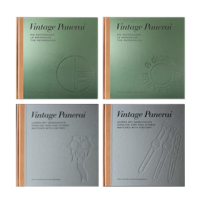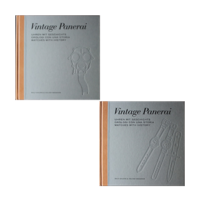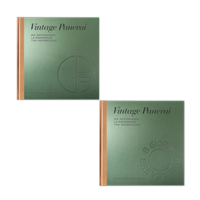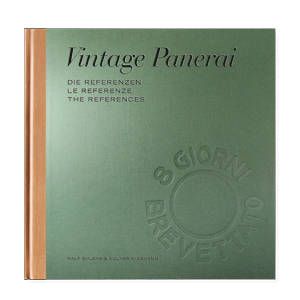Tag: 696
Found: another Ref. 3646 / Type D “Kampfschwimmer”
by Volker on Jun.29, 2017, under Allgemein
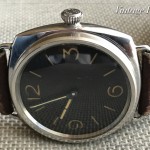 Introducing another piece of the puzzle – and one more surfaced in Germany: a Ref. 3646 / Type D with anonymous sandwich dial and rare “Kampfschwimmer” engraving with initials of the first owner and year of service (1945) on its outer caseback. The watch is accompanied with matching paperwork of the first owner, dating back to 1944, as well as a small compass.
Introducing another piece of the puzzle – and one more surfaced in Germany: a Ref. 3646 / Type D with anonymous sandwich dial and rare “Kampfschwimmer” engraving with initials of the first owner and year of service (1945) on its outer caseback. The watch is accompanied with matching paperwork of the first owner, dating back to 1944, as well as a small compass.
The watch has been added into our database in early May 2017 and appears with high bezel (a typical feature of the watches with sandwich dials), onion shaped “Brevet +” crown (Type 11) and Rolex Cal. 618 / Type 1 movement. The watch has never been polished and still has its original “volcano dome” plexi as well as the original leather strap and large, nickel-plated brass pin buckle. The blued steel hands still hold their complete luminous material. The inner caseback is signed with the Rolex SA hallmark, reference and case number.
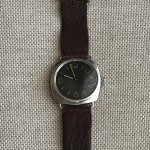 Watches of the Reference 3646 / Type D are featured in our book “The References” 1930’s-1940’s in chapter II.IV (page 398-531). Small compasses are featured in chapter IV (where a similar version is shown on page 672-675). Chapter V holds information on straps and buckles (page 679-685 featuring the “bottle opener” shaped pin buckles).
Watches of the Reference 3646 / Type D are featured in our book “The References” 1930’s-1940’s in chapter II.IV (page 398-531). Small compasses are featured in chapter IV (where a similar version is shown on page 672-675). Chapter V holds information on straps and buckles (page 679-685 featuring the “bottle opener” shaped pin buckles).
Thanks to the owner who provided information for our database.
[Ralf Ehlers & Volker Wiegmann]
Evolution.
by Volker on Feb.18, 2017, under Allgemein
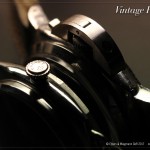 The evolution of Vintage Panerai watches from Guido Panerai & Figlio from the 1930’s to the 1960’s can be symbolized in a photo like the one shown here: from a cushion shaped case with soldered lugs and an onion shaped crown to a much stronger, massive case with solid lugs and the legendary crown-protecting device.
The evolution of Vintage Panerai watches from Guido Panerai & Figlio from the 1930’s to the 1960’s can be symbolized in a photo like the one shown here: from a cushion shaped case with soldered lugs and an onion shaped crown to a much stronger, massive case with solid lugs and the legendary crown-protecting device.
The early References 2533 (chapter I) and 3646 (chapter II) are explained and with rich reference to several variants by their number groups in the first volume “The References” 1930’s-1940’s. This overview is complimented by the legendary Mare Nostrum chronograph (chapter III), rare compasses (chapter IV) used in the Second World War and some of the few straps and buckles which rarely survived after more than 70 years (chapter V). Find information about the content of our book “The References” 1930’s-1940’s by using the “browse by tag” function. The tag 696 is connected with all stories published about the first volume: watches, history, instruments and straps of the 1930’s-1940’s.
“The References” 1950’s-1960’s features numerous images and historic information on Vintage Panerai watches from the 1950’s to 1960’s. The References 6152 (chapter VI) and 6154 (chapter VII), are followed by Reference 6152/1 with the famous crown-protecting device are explained in detail and many variations in chapter VIII. Followed by the Reference GPF 2/56 with Angelus movement (chapter IX), “The References” 1950’s-1960’s features in chapter X the Modified References 3646, Transitional 3646 and Modified Reference 6152/1. Chapter XI is about compasses and depth gauges, followed by the last chapter XII, an overview of the straps and buckles used on watches and instruments from Guido Panerai & Figlio in this era. Find information about the content of our book “The References” 1950’s-1960’s by using the “browse by tag” function. The tag 1392 is connected with all stories published about the second volume: watches, history, instruments and straps of the 1950’s-1960’s.
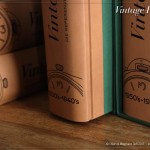 “The References” 1930’s-1940’s
“The References” 1930’s-1940’s
Embossed hardback jacket (leather and canvas), slipcase,
696 pages, five chapters, trilingual
(German, English and Italian language)
“The References” 1950’s-1960’s
Embossed hardback jacket (leather and canvas), slipcase,
696 pages, seven chapters, trilingual
(German, English and Italian language)
The spine of our both “The References” books are embossed with the symbols of evolution, just like the first photo above shows it at a glance: from a cusion shaped case with soldered lugs and an onion shaped crown (“The References” 1930’s-1940’s) to a much stronger, massive case with solid lugs and the legendary crown-protecting device (“The References” 1950’s-1960’s). Visit our bookstore and enjoy reading soon!
[Ralf Ehlers & Volker Wiegmann]
Click ‘696’ to find info on “The References” 1930’s-1940’s at a glance
by Volker on Jan.14, 2017, under Allgemein
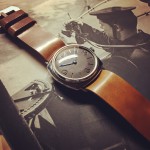 Find information about the content of our book “The References” 1930’s-1940’s by using the “browse by tag” function. The tag 696 is connected with all stories published about the first volume: watches, history, instruments and straps of the 1930’s-1940’s.
Find information about the content of our book “The References” 1930’s-1940’s by using the “browse by tag” function. The tag 696 is connected with all stories published about the first volume: watches, history, instruments and straps of the 1930’s-1940’s.
The photo on the left shows a Ref. 3646 / Type D (featured in chapter II.IV) placed on a historic photo of a cunning tower of a Royal Italian Navy submarine, on which an instrument (aiming device, described as “traguardo di puntamento per il lancio di siluri”) with luminous Radiomir display from Guido Panerai & Figlio can be seen on the left. The firm and close contact with the Royal Italian Navy, which existed many years prior to the start of producing watches, meant that a prerequisite had been established within Panerai: One only uses the best components.
The early References 2533 (chapter I) and 3646 (chapter II) are explained and with rich reference to several variants by their number groups. This overview is complimented by the legendary Mare Nostrum chronograph (chapter III), rare compasses (chapter IV) used in the Second World War and some of the few straps and buckles which rarely survived after more than 70 years (chapter V).
“The References” books are in stock and ready for shipping – just visit our bookstore and enjoy reading soon! [Ralf Ehlers & Volker Wiegmann]
Ref. 3646 watches with disappeared Rolex hallmarks
by Volker on Jan.14, 2017, under Allgemein
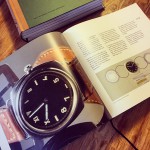 Why do some Ref. 3646 watches come only with a six digit case number embossed on their inner caseback? Where did the Rolex hallmark and reference number go? In which of the seven different number groups of the Reference 3646 is this the case?
Why do some Ref. 3646 watches come only with a six digit case number embossed on their inner caseback? Where did the Rolex hallmark and reference number go? In which of the seven different number groups of the Reference 3646 is this the case?
Our book “The References” 1930’s-1940’s answers these questions in two chapters by measurement results and illustrated cross-sections (page 537-551, 638-639 and 644-645). The coffee table shot on the left shows a Ref. 3646 / Type G with a technical illustration on page 618-619 in chapter II.VII.
Chapter II.V = Reference 3646 / Type E
(featuring four different watches on page 532-573).
Chapter II.VII = Reference 3646 / Type G
(featuring two different watches on page 608-645).
“The References” books are in stock and can be ordered in our bookstore. Enjoy reading!
The weak spot of the 3646
by Volker on Jan.04, 2017, under Allgemein
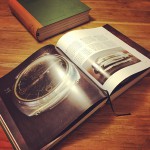 With regard to the evolution of watches from Guido Panerai & Figlio, one particular weak point has been often mentioned that has been improved hugely over time: the strap loops soldered on to the pillow-shaped casing of the Reference 3646. With the Radiomir watch shown here, a Ref. 3646 / Type B with riveted plastic dial, we can take a closer look at precisely this weak point and show an example of a Reference 3646 that was not returned to its original condition after being damaged. The watch shown in the photo on left is described in detail on page 228-237 in chapter II.II of our book “The References” 1930’s-1940’s.
With regard to the evolution of watches from Guido Panerai & Figlio, one particular weak point has been often mentioned that has been improved hugely over time: the strap loops soldered on to the pillow-shaped casing of the Reference 3646. With the Radiomir watch shown here, a Ref. 3646 / Type B with riveted plastic dial, we can take a closer look at precisely this weak point and show an example of a Reference 3646 that was not returned to its original condition after being damaged. The watch shown in the photo on left is described in detail on page 228-237 in chapter II.II of our book “The References” 1930’s-1940’s.
With the experience collected during the Second World War, the aim was primarily to increase the stability of the watches’ lugs. The soldered wire watch loops had been revealed as a weak spot and Guido Panerai & Figlio worked hard to improve them and the result was a success – in shape of the watches of the Reference 6152, 6154, 6152/1 and last but not least the huge GPF 2/56. The lugs of these watches were all created out of the casing itself and no longer soldered on (read also page 723-733 in chapter VI of our book “The References” 1950’s-1960’s) as it was the case with the watches of the Reference 3646.
One reference, seven variations: The 3646 / Type A-G
by Volker on Oct.12, 2016, under Allgemein
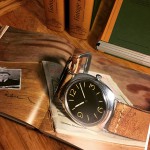 More than two hundred watches of the reference 3646 are registered in our database today. Among all different Vintage Panerai models, the 3646 marks the reference with the most known specimen in our records. In 2009, seven years ago, 143 recorded watches were featured in the first (sold out) edition of our book “The References”. Within the entire serial number sequence of the reference 3646, we differentiate between seven different variations (3646 / Type A-G).
More than two hundred watches of the reference 3646 are registered in our database today. Among all different Vintage Panerai models, the 3646 marks the reference with the most known specimen in our records. In 2009, seven years ago, 143 recorded watches were featured in the first (sold out) edition of our book “The References”. Within the entire serial number sequence of the reference 3646, we differentiate between seven different variations (3646 / Type A-G).
In our new book “The References” 1930’s-1940’s the watches of the entire reference 3646 are featured in chapter II with more than six hundred pages in the chapters II.I-II.VII following an intro on page 40-49. The seven different variations can be found in our reference quickfinder on page 14-20. The coffee table shot on the left shows one of seven specimen of the Ref. 3646 / Type C, introduced on page 322-349. Read also the extensively documented story of Helmut Rösel, first owner of this watch, in chapter IX of our book “History2”. Each of the seven variations of the reference 3646 are published here:
Chapter II.I = Reference 3646 / Type A
(featuring two different watches on page 50-169).
Chapter II.II = Reference 3646 / Type B
(featuring four different watches on page 170-247).
Chapter II.III = Reference 3646 / Type C
(featuring seven different watches on page 248-397).
Chapter II.IV = Reference 3646 / Type D
(featuring nine different watches on page 398-531).
Chapter II.V = Reference 3646 / Type E
(featuring four different watches on page 532-573).
Chapter II.VI = Reference 3646 / Type F
(featuring two different watches on page 574-607).
Chapter II.VII = Reference 3646 / Type G
(featuring two different watches on page 608-645).
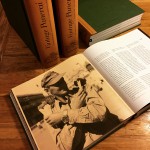 Aside numerous photos and technical illustrations of these 30 different watches, we have also published several yet unreleased historic photos of frogmen wearing watches of the reference 3646 during the Second World War.
Aside numerous photos and technical illustrations of these 30 different watches, we have also published several yet unreleased historic photos of frogmen wearing watches of the reference 3646 during the Second World War.
One of these rare photos shows “Kampfschwimmer” Werner Bullin on page 275 in chapter II.III, wearing his 3646 with “Radiomir Panerai” dial. The coffee table shot on the left shows this photo which was taken at Piazza San Marco / Venice in summer 1944. Another rare photo has been introduced earlier here. Read the extensively documented story of Werner Bullin and Heinz Günter Lehmann over the 75 pages of chapter I in our book “History1”.
The new “The References” books can be ordered only in our bookstore. Enjoy reading!
Ref. 3646 / Type D “Kampfschwimmer” @ Phillips GWA4
by Volker on Sep.24, 2016, under Watch Point
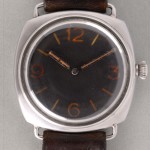 Phillips will feature a Ref. 3646 / Type D “Kampfschwimmer” in their Geneva Watch Auction: FOUR. The watch is recorded in our database since 2006, when it was auctioned for the first time in Germany at Dr. Crott Auctioneers. By its inner and outer details it is representing a typical “Kampfschwimmer” watch with anonymous sandwich dial, onion shaped “Brevet +” crown (Type 11) and Rolex Cal. 618 / Type 1 movement.
Phillips will feature a Ref. 3646 / Type D “Kampfschwimmer” in their Geneva Watch Auction: FOUR. The watch is recorded in our database since 2006, when it was auctioned for the first time in Germany at Dr. Crott Auctioneers. By its inner and outer details it is representing a typical “Kampfschwimmer” watch with anonymous sandwich dial, onion shaped “Brevet +” crown (Type 11) and Rolex Cal. 618 / Type 1 movement.
It appears to be one of only a few specimen which still have their original leather strap and original pin buckle. This particular watch is featured – in detail – in our new book “The References” 1930’s-1940’s in chapter II.IV (Ref. 3646 / Type D) on page 516-523 as well as in chapter V (Straps and Buckles) on page 678.
Further info on this watch (lot 152) can be found here.
We hope that also this watch will find a good new home and remains surfaced in the Vintage Panerai collectors world. [Ralf Ehlers & Volker Wiegmann]
[Photo with kindly permission / courtesy of www.phillips.com]
One more 3646 / Type D with brass dial surfaced in the UK
by Volker on Sep.18, 2016, under Allgemein
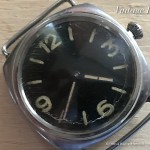 Introducing another piece of the puzzle – and one more surfaced in the United Kingdom: a Ref. 3646 / Type D with black painted brass dial and rare “Kampfschwimmer” engraving with initials of the first owner on its outer caseback. After more than 70 years the watch changed ownership once again and recently found a good new home at a Panerai collector from Germany, who provided the photo shown on the left.
Introducing another piece of the puzzle – and one more surfaced in the United Kingdom: a Ref. 3646 / Type D with black painted brass dial and rare “Kampfschwimmer” engraving with initials of the first owner on its outer caseback. After more than 70 years the watch changed ownership once again and recently found a good new home at a Panerai collector from Germany, who provided the photo shown on the left.
The watch has been added into our database in March 2016 and comes with flat bezel (a typical feature of the watches with flat dials), onion shaped “Brevet +” crown (Type 11) and Rolex Cal. 618 / Type 1 movement. The watch has never been polished and has still its original plexi, showing the typical traces of aging. The inner caseback is signed with the Rolex SA hallmark, reference and case number. A similar 3646 / Type D watch with flat bezel and black painted brass dial will be auctioned in Glasgow on September 23rd, 2016 at Great Western Auctions.
A Ref. 3646 / Type D watch with black painted brass dial is featured in our book “History1” in chapter III together with the history of its first owner, a German “Kampfschwimmer” who provided us very interesting information about his service, training and how some of these Panerai watches “changed ownership” during the time when he was a POW (prisoner of war) in the summer of 1945 (page 206-207).
Watches of the Reference 3646 / Type D are also featured in our new book “The References” 1930’s-1940’s in chapter II.IV (page 398-531) including a historic photo of a German “Kampfschwimmer” wearing a 3646 with brass dial on page 475.
Click ‘696’ to find info on “The References” 1930’s-1940’s at a glance
by Volker on Aug.25, 2016, under Allgemein
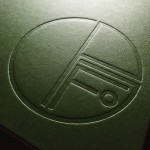 Find information about the content of our new book “The References” 1930’s-1940’s by using the “browse by tag” function. The tag 696 is connected with all stories published about the first volume: watches, history, instruments and straps of the 1930’s-1940’s.
Find information about the content of our new book “The References” 1930’s-1940’s by using the “browse by tag” function. The tag 696 is connected with all stories published about the first volume: watches, history, instruments and straps of the 1930’s-1940’s.
The first volume (page 1-696) of the two-book-set “The References” is bearing the embossed GPF logo on the green canvas hardback jacket.
Our new “The References” books are in stock and ready for shipping – just visit our bookstore and enjoy reading soon! [Ralf Ehlers & Volker Wiegmann]
“Two smurfs riding a carrot?”
by Volker on Aug.08, 2016, under Allgemein
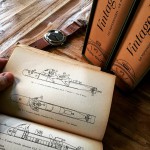 …no, thats not the way we would describe the illustration of a SLC (which still represents a piece of the heritage on some of the latest Panerai watches e.g. PAM00425 or PAM00577, ). Even during its development in the “early days” before the Second World War, it was nicknamed “maiale” (pig) from those who were testing it at Porto Santo Stefano, La Spezia and Bocca di Serchio from October 1935 to August 1936.
…no, thats not the way we would describe the illustration of a SLC (which still represents a piece of the heritage on some of the latest Panerai watches e.g. PAM00425 or PAM00577, ). Even during its development in the “early days” before the Second World War, it was nicknamed “maiale” (pig) from those who were testing it at Porto Santo Stefano, La Spezia and Bocca di Serchio from October 1935 to August 1936.
Looking back into the history of the legendary “Human Torpedo” (as it was often named), one of the inventors of the SLC (Siluro a lenta Corsa / slow running torpedo), Elios Toschi, once described the two-man torpedo as “a mini, electrically powered submersible with a completely new design, whose crew (pilot and copilot) ride the torpedo in a sitting position and will thus be able to target enemy ports at night in cover of darkness using luminescent instruments to navigate. On their way to their targets, they are in a position when underwater to be able to cut through net barricades, remove obstacles and operate with great endurance at depths of up to 30 metres thanks to their breathing equipment…”
Read more about “The birth of a legend – the first Panerai watches (1935-1939)” in chapter I, followed by the timeline of the missions of the Mezzi d’Assalto during the Second World War in chapter II.I – more information on the historic content in our “The References” book set with a total of 1392 pages can be found here and here. Read about the featured watches from Guido Panerai & Figlio in the first and second volume here.

